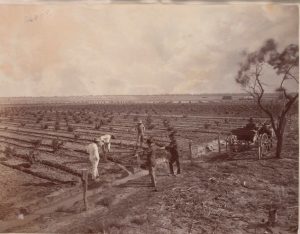by Dr. Ruth Morgan (LMU Munich)
The combined forces of engineering and imperialism still often conjure images of heroic enterprise on a vast scale and across long time periods, resulting in the enormous transformation of places and peoples for empire’s ends. Collectively, the papers of “Engineering Imperialism, Building Empire”, sought to redress this grand narrative through the exploration of engineering and engineering works as sites for everyday encounter.1 Drawing on David Edgerton’s case for “technology-in-use” and David Arnold’s concept of “everyday technology”, we each focused on a tool or infrastructure that advanced and sustained colonial mobilities within and across European and North American empires in Africa, Asia, and Australia.2 Typically understood as machines of modernity that revolutionised time and space, in our panel, ships, rickshaws, canals, and railroads became spaces for excavating colonial power relations of labour, race and gender.
Late nineteenth century Australian settlers’ admiration for the feats of British engineers in “irrigated India” was the focus of my paper. Seeking measures to overcome the agrarian limits of aridity, pastoralists and politicians from the colonies of South Australia and Victoria undertook their own “observatory tours” of British India.3 Although they marvelled at the scale of the waterworks they encountered, the hydrological and labour conditions of their own settler colonies meant that there was little likelihood of replicating these engineering schemes. Across the Pacific, they saw the irrigated agriculture of California as a more favourable model for their ambitions of closer settlement and the formation of a white settler Commonwealth. Their conclusions in this respect reflected Australia’s general turn towards the United States in terms of natural resource management at the turn of the twentieth century.4

J.W. Lindt, “Irrigation at Mornington plantation”, Mildura, 1890. H96.160/1915, State Library Victoria, Australia.
What their travel accounts of colonial South Asia also revealed was their observations of the colonial hydrology of India and the nature of the colonial hydrology they sought to forge in the Australian colonies. South Asian environmental historian Rohan d’Souza has proposed the concept of ‘colonial hydrology’ to describe the social worlds of water and to reveal ‘the broader dynamics of colonial rule’.5 D’Souza’s concept can be used to read the writings of Alfred Deakin, one of the Australian observers, who wrote expansively on the labour processes required to engineer India’s great rivers. The regulation of a river, Deakin believed, was the reward for an ever-vigilant Anglo-engineer, while failures in the system were solely attributable to the poorly skilled Indian workers. The task of the Anglo-engineer was an especially challenging one, so Deakin explained, for the engineer, an avatar of modernity, had to manage both an unruly river and a backward people, who lived “in practically another age”.6 Framing Indian subjects in this way justified the need for paternalist government in India, while suggesting that white Australians might best follow the example of the United States and its “restlessly inventive and progressive Americans”.7 Deakin’s account of “irrigated India”, therefore, emasculated subaltern labour in order to celebrate the labour of white men – British and North American engineers and the Australian yeoman farmer: a white brotherhood based on technical mastery. It was these men, their wives and children, who would be the foundation of the “white man’s country” that Deakin would help to forge through the federation of the Australian colonies less than a decade later in 1901.
The colonial allure of American expertise was a theme explored in Steve Tuffnell’s paper, which examined networks of “trans-imperial” engineering in Britain’s African outposts at the turn of the twentieth century. The investment of US capital and engineering expertise in colonial rail projects, Tuffnell argued, encouraged the co-production of colonial rule through coercive and extractive forms of labour discipline developed in the plantation south and the western frontier. Charles Fawell, meanwhile, took us below deck on a steamship voyaging from Marseille to Yokohama in the early twentieth century, where he teased out the volatile labour relations of trans-imperial transit. The focus here was not the glamour of steam travel, but the politics of cohabitation that were produced in a place that was effectively both a hotel and a coal plant. Finally, Chao Ren navigated the “rickshaw zone”, a network that linked China and Japan to the British outposts of southeast and south Asia through the proliferation of this form of passenger transport. The rickshaw fostered intimate imperial encounters between elites and the subjects upon whose physical labour their mobility relied.
Our shared concern with the everyday operation — as opposed to the macro-historical mythologies — of colonial engineering and infrastructure led us to question “whose everyday” featured in these case studies. The written and pictorial sources that informed our studies were intended mostly for elite audiences, both in the colonies and the metropole. Reading these sources against the grain revealed that empire’s civilising mission and the hierarchies that it structured were embedded in these everyday technologies of imperial mobility, and should be grasped accordingly by historians.
Footnotes
1 The other panellists were: Chao Ren (University of Michigan), “Everyday Mobilities: A Trans-Imperial History of the Hand-Pulled Rickshaw, 1870-1930”; Stephen Tuffnell (Oxford), “Transimperialism, Inc.: US Expansion and the Making of British Africa”; Charles Fawell (University of Chicago), “The Colonial Steamship ‘East of Suez’: Conflict and Collaboration in the In-Between Spaces of Empire, 1880-1918”.
2 David Edgerton, The Shock of the Old: Technology and Global History since 1900, London: Profile Books, 2011; David Arnold, Everyday Technology: Machines and the Making of India’s Modernity, Chicago: University of Chicago Press, 2013.
3 Alfred Deakin, Irrigated India: An Australian View of India and Ceylon, Their Irrigation and Agriculture, Melbourne: E.A. Petherick, 1893, p. 5.
4 See for example, Ian Tyrrell, True Gardens of the Gods: Californian-Australian Environmental Reform, 1860-1930, Berkeley, CA: University of California Press, 1999.
5 Rohan d’Souza, “Water in British India: The Making of a ‘Colonial Hydrology’,” History Compass 4, no. 4 (2006): 621.
6 Deakin, p. 25.
7 Deakin, p. 147.
